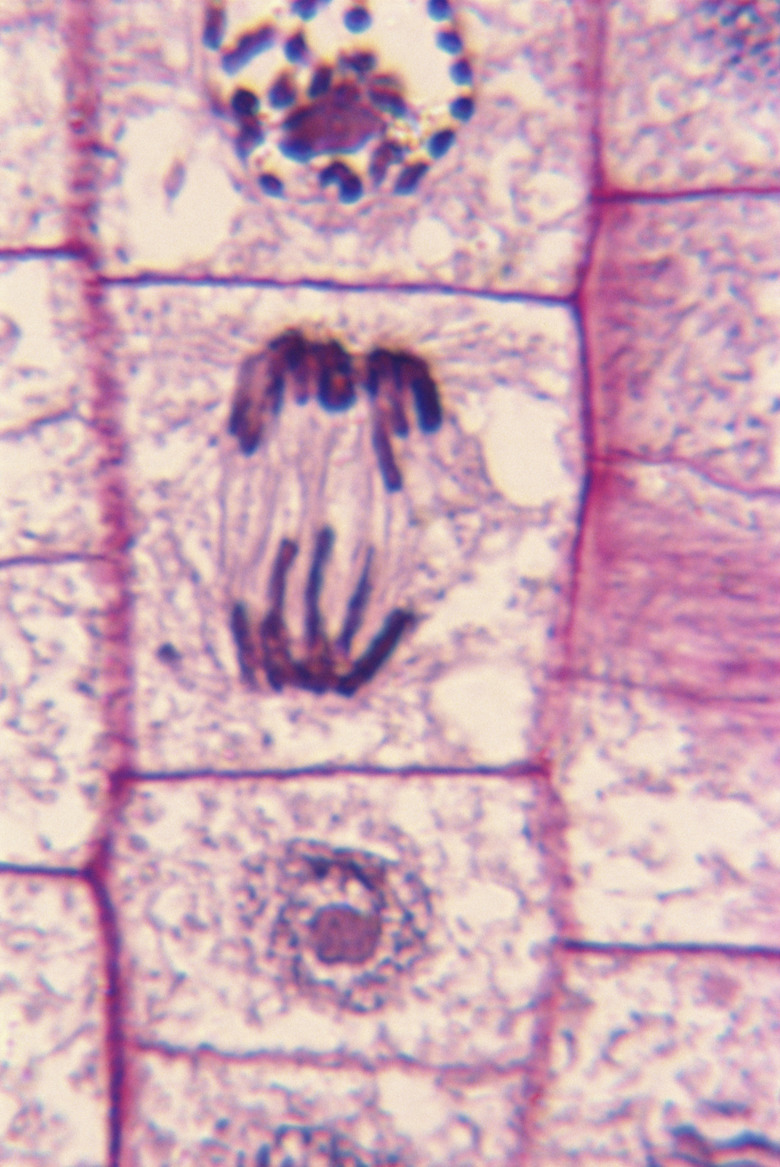DNA Is Condensed In What Phases?
For billions of years, living organisms have survived, reproduced and adapted through transmission of deoxyribonucleic acid (DNA) from one generation to the next. One of the greatest marvels of science is how a microscopic cell manages to convey all the instructions necessary for morphing into an ant, elephant or human being. Mistakes in DNA duplication and separation may result in premature death or mutation. Chromosomes are most compacted (condensed) when lining up in metaphase and dividing in telophase to keep DNA molecules intact.
Understanding Key Concepts
Understanding Key Concepts
The sequence of bases in a strand of DNA makes up each individual's unique genome. Advanced life forms like eukaryotic cells contain a nucleus that houses genetic material (chromosomes) when the cell is growing normally. DNA condenses into chromosomes. When the time is right for the cell to divide, the nuclear membrane disassembles, and chromosomes are on the move.
The structure of a chromosome has everything to do with what the purpose of each phase of the cell cycle. It is easier to remember when chromosomes condense once you understand why chromosomes are compacted in the first place. Understanding the definition of chromatin and chromosomes is a good starting point.
- Chromatin fiber
is made up of nucleosomes that form when the DNA base pairs, A, T, C and G, coil around histones (alkaline proteins). Chromatin carefully packs these DNA molecules into stringy-looking structures called chromosomes. If the DNA molecules in cells were not snaked around histones, the molecules would be 6 feet long when placed end-to-end, according to the National Human Genome Research Institute.
- Chromosome pairs are
housed inside the nucleus of eukaryotic cells for safe keeping. Chromosomes cannot be seen under a microscope unless the chromosomes are condensed in a dividing cell. A chromosome has a constricting centromere – often in the middle – giving it a characteristic X shape.
Mitosis: Asexual Reproduction
Mitosis: Asexual Reproduction
Animal, plant and human bodies typically grow and repair tissue by undergoing asexual reproduction (mitosis) in somatic (non-reproductive) cells with a full set of chromosomes. Cell division starts when the cell has absorbed sufficient nutrients and replicated DNA in the nucleus. Sister chromatids line up and then divide to form new cells, identical to the parent cell. Mitosis is a fast and efficient way to increase cell count and replace unhealthy cells.
Meiosis: Genetics of Reproduction
Meiosis: Genetics of Reproduction
Animals, higher-order plants and humans pass their genes on to their offspring through the process of meiosis. The first phase of cell division differs from mitosis by a random exchange of genes in haploid sex cells. Chromosomes line up and exchange gene snippets, divide across the cytoplasm and form sperm, an egg or spores. A fertilized egg grows into an organism that is both genetically similar and different from parents.
DNA Changes During Cell Cycle
DNA Changes During Cell Cycle
During normal cell growth, chromatin condenses into chromosomes not yet visible under a light microscope. This is a stage called interphase. Chromotid replicates into two halves held together by a centromere. After these sister chromatids are formed, the next phase of the cell cycle proceeds; this is prophase, when chromatin condenses into chromosomes to the point where sister chromatids can be seen under a light microscope.
Next is metaphase; chromosomes are highly condensed and quite visible under a light microscope when they line up on the metaphase plate at the center of the cell. (Chromosomes form tetrads when they enter metaphase during meiosis. A tetrad includes one pair of sister chromatids from the mother and one pair of sister chromatids from the father.) Next up is anaphase, in which the chromatids start to move apart, heading to each end of the cell. Finally, there's telophase: A nuclear envelope forms in each cell and DNA de-condenses into chromatin.
Cite This Article
MLA
Dowd, Mary. "DNA Is Condensed In What Phases?" sciencing.com, https://www.sciencing.com/dna-condensed-phases-12049431/. 15 April 2019.
APA
Dowd, Mary. (2019, April 15). DNA Is Condensed In What Phases?. sciencing.com. Retrieved from https://www.sciencing.com/dna-condensed-phases-12049431/
Chicago
Dowd, Mary. DNA Is Condensed In What Phases? last modified August 30, 2022. https://www.sciencing.com/dna-condensed-phases-12049431/
